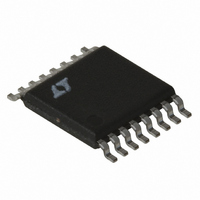LT3430IFE#TR Linear Technology, LT3430IFE#TR Datasheet - Page 13

LT3430IFE#TR
Manufacturer Part Number
LT3430IFE#TR
Description
IC REG SW STDN 3A 200KHZ 16TSSOP
Manufacturer
Linear Technology
Type
Step-Down (Buck)r
Datasheet
1.LT3430EFE-1PBF.pdf
(28 pages)
Specifications of LT3430IFE#TR
Internal Switch(s)
Yes
Synchronous Rectifier
No
Number Of Outputs
1
Voltage - Output
1.2 ~ 54 V
Current - Output
3A
Frequency - Switching
200kHz
Voltage - Input
5.5 ~ 60 V
Operating Temperature
-40°C ~ 125°C
Mounting Type
Surface Mount
Package / Case
16-TSSOP Exposed Pad, 16-eTSSOP, 16-HTSSOP
Lead Free Status / RoHS Status
Contains lead / RoHS non-compliant
Power - Output
-
Available stocks
Company
Part Number
Manufacturer
Quantity
Price
APPLICATIONS INFORMATION
where:
f = switching frequency
t
V
V
I • R = inductor I • R voltage drop
If this condition is not observed, the current will not be
limited at I
higher value. Using the nominal LT3430/LT3430-1 clock
frequencies of 200KHz/100kHz, a V
I • R) of say 0.7V, the maximum t
would be approximately 90ns for the LT3430 and 180ns
for the LT3430-1, unacceptably short times.
The solution to this dilemma is to slow down the oscil-
lator when the FB pin voltage is abnormally low thereby
indicating some sort of short-circuit condition. Oscillator
frequency is unaffected until FB voltage drops to about
2/3 of its normal value. Below this point the oscillator
frequency decreases roughly linearly down to a limit of
about 40kHz. (30kHz for LT3430-1) This lower oscillator
frequency during short-circuit conditions can then maintain
control with the effective minimum on time.
It is recommended that for [V
10, a soft-start circuit should be used for the LT3430 to
control the output capacitor charge rate during start-up
or during recovery from an output short circuit, thereby
adding additional control over peak inductor current. See
Buck Converter with Adjustable Soft-Start later in this
data sheet.
OUTPUT CAPACITOR
The output capacitor is normally chosen by its effective
series resistance (ESR), because this is what determines
output ripple voltage. To get low ESR takes volume, so
physically smaller capacitors have high ESR. The ESR
range for typical LT3430 applications is 0.05Ω to 0.2Ω.
A typical output capacitor is an AVX type TPS, 100µF at
10V, with a guaranteed ESR less than 0.1Ω (The LT3430-1
will typically use two of these capacitors in parallel). This
is a “D” size surface mount solid tantalum capacitor. TPS
capacitors are specially constructed and tested for low
ESR, so they give the lowest ESR for a given volume. The
value in microfarads is not particularly critical, and values
ON
F
IN
= diode forward voltage
= switch minimum on time
= Input voltage
PK
, but will cycle-by-cycle ratchet up to some
IN
/(V
ON
IN
OUT
to maintain control
of 40V and a (V
+ V
F
)] ratios >
F
+
from 22µF to greater than 500µF work well, but you cannot
cheat mother nature on ESR. If you fi nd a tiny 22µF solid
tantalum capacitor, it will have high ESR, and output ripple
voltage will be terrible. Table 3 shows some typical solid
tantalum surface mount capacitors.
Many engineers have heard that solid tantalum capacitors
are prone to failure if they undergo high surge currents. This
is historically true, and type TPS capacitors are specially
tested for surge capability, but surge ruggedness is not
a critical issue with the output capacitor. Solid tantalum
capacitors fail during very high turn-on surges, which
do not occur at the output of regulators. High discharge
surges, such as when the regulator output is dead shorted,
do not harm the capacitors.
Unlike the input capacitor, RMS ripple current in the output
capacitor is normally low enough that ripple current rating
is not an issue. The current waveform is triangular with
a typical value of 250mA
this is:
Output capacitor ripple current (RMS):
Ceramic Capacitors
Higher value, lower cost ceramic capacitors are now
becoming available. They are generally chosen for their
good high frequency operation, small size and very low
ESR (effective series resistance). Their low ESR reduces
output ripple voltage but also removes a useful zero in the
loop frequency response, common to tantalum capaci-
tors. To compensate for this, a resistor R
in series with the V
must be taken however, since this resistor sets the high
Table 3. Surface Mount Solid Tantalum Capacitor ESR
and Ripple Current
E Case Size
AVX TPS, Sprague 593D
D Case Size
AVX TPS, Sprague 593D
C Case Size
AVX TPS
I
RIPPLE RMS
(
)
=
0 29
.
C
compensation capacitor C
ESR (Max., Ω )
(
LT3430/LT3430-1
V
0.1 to 0.3
0.1 to 0.3
RMS
OUT
( )( )( )
0.2 (typ)
L f V
. The formula to calculate
)
(
V
IN
IN
−
V
OUT
Ripple Current (A)
C
)
can be placed
0.7 to 1.1
0.7 to 1.1
0.5 (typ)
13
C
. Care
34301fa













